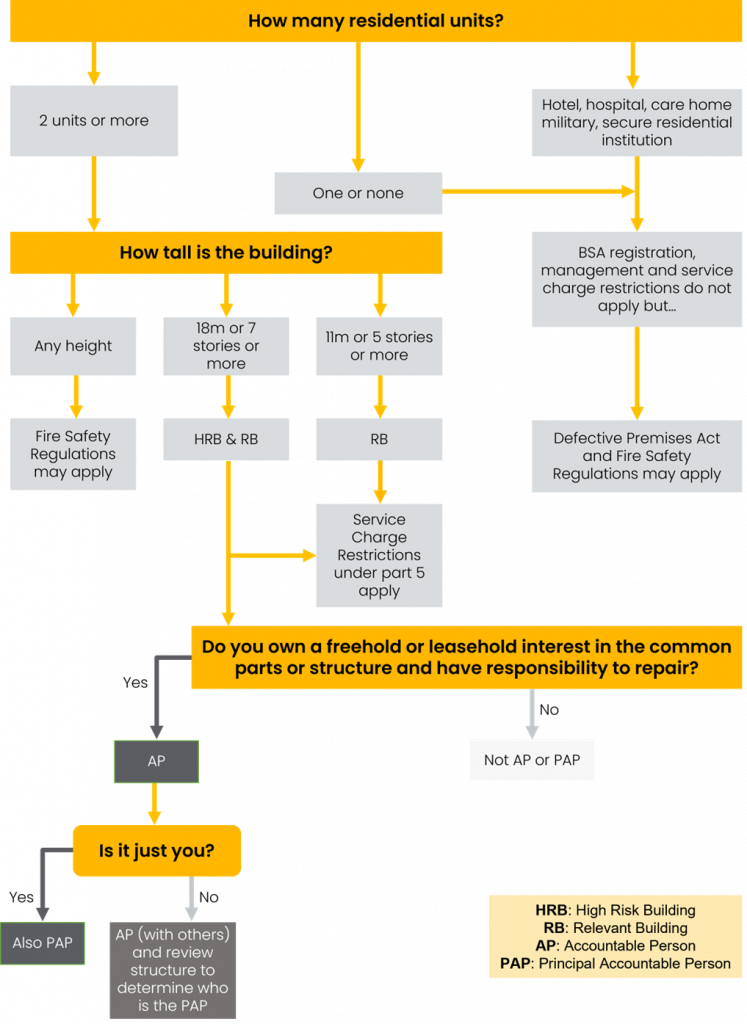Once a higher risk building is occupied, there are two main areas of the BSA that property investors should consider:
- the management of “building safety risks” and who is responsible; and
- the recovery of the costs of carrying out safety measures and remedial works.
Both of which are covered in our series of articles concerning mixed use higher-risk buildings in England. (Click here to view these articles).
What is a building safety risk?
Given that the aim of the BSA is to improve the safety of buildings, particularly those deemed to be higher risk, the concept of what is a building safety risk is wide – a risk to the safety of people in or around a building arising from the spread of fire or structural failure.
The obligations relating to the management of these risks is set out in part 4 of the BSA and they apply to HRBs (see article 1 for the meaning of HRB) that are occupied. Occupied for this purpose means if one or more residential unit is lived in.
Who is responsible?
The BSA, together with various sets of regulations, sets out key responsibilities for the Principal Accountable Person (“PAP”) and an Accountable Person (“AP”) (of which any building could have any number of APs) for the assessment and management of safety risks in higher risk buildings.
An AP is a person that holds a legal estate of the common parts or the structure of the building unless there is someone else that doesn’t have a legal estate but is under an obligation to repair the structure or the common parts (such as a management company). In which case, the person with the repairing obligation of the structure or common parts is an AP.
Whilst any building could have multiple APs, there is only one PAP. The PAP is the person that holds a legal estate in possession in the structure and exterior of the building or the person who is under the repairing obligation for the structure and the common parts. There is a whole set of regulations and further guidance to help determine which you are but it can easily become very complicated.
What are the obligations of PAPS and APS?
The government published detailed guidance on 19 September 2023 to help PAPs and APs understand how to comply (“Guidance“). Whilst this note is no substitute for the details across the BSA, regulations and Guidance, it sets out some helpful pointers.

- REGISTRATION OF THE BUILDING WITH THE REGULATOR
The PAP is responsible for registering the HRB with the Building Safety Regulator (“Regulator“). Please see article 1 for further information.
- PRE-OCCUPATION REQUIREMENTS
An AP commits an offence if a relevant residential unit is occupied before a building regulations completion certificate under the Building Act 1984 has been issued (unless there is a reasonable excuse) where:
- there is a newly constructed HRB (in which case, the pre-occupation requirement applies to the whole HRB);
- residential units are being added to such a building (in which case, the pre-occupation requirement applies to the occupation of the additional residential units); and
- works to a building cause it to become an HRB (in which case, the pre-occupation requirement applies to the occupation of the newly-created residential units).
- ASSESSING SAFETY RISKS AND SAFETY CASE REPORTING IN HRBS
The PAP must carry out a safety case report containing specific details as set out in the regulations. This includes a description of the all the possible scenarios of building safety risks identified by each AP, the likelihood of those risks materialising and an assessment of the likely consequences if they do materialise. Such as single-floor/multiple floor scenarios for fire safety.
It is therefore recommended that each AP assembles a risk assessment team. The team should comprise people with knowledge and experience of safety management systems, fire safety and structural safety. “All reasonable steps” should be taken to prevent and mitigate building safety risks.
In order for the PAP to carry out that assessment, each AP must have their own report available and in an easily accessible digital format. The individual APs report must contain:
- details of who prepared the report;
- a building description;
- a risk assessments summary;
- a managing risks summary;
- a summary of the safety management system;
- details on planning for emergencies; and
- details on ongoing work and building improvement.
- SAFETY MANAGEMENT SYSTEMS FOR HRBS
APs must take steps to manage building safety risks in accordance with prescribed principles set out in the Higher-Risk Buildings (Management of Safety Risks etc) (England) Regulations 2023 (“Safety Risks Regulations“) which are supplemented by more government guidance to help support decision making for APs. A safety management system (“SMS“) is a formal management system or framework for managing safety risks. The SMS should reflect the hazards of the individual building and any particular complexities. It will be crucial for the PAPs and APs to review and update their systems, policies, and procedures and the overall aim is for continuous improvement.
- MANDATORY OCCURRENCE REPORTING REQUIREMENTS
An AP is required to make mandatory reports to the Regulator following a safety occurrence which will include the nature of the occurrence and a description of the measures taken to mitigate or remedy the safety occurrence. A “safety occurrence” is widely defined as an incident or situation relating to the structural integrity of, or spread of fire in, an HRB that meets the “risk condition”. The “risk condition” is met if use of part of the building without the incident or situation being remedied would be likely to present a risk of death or serious injury.
APs should not assume their duties can be fulfilled by their property managers. The statutory liability vests with the AP. Under the property management agreement the AP may have contractually obliged the property manager to deal with fire safety obligations. A breach might allow the AP to have a breach of contract claim against the manager but the statutory liability for the AP remains. APs therefore need a close dialogue with their property managers and perhaps implement their own processes to ensure that their property manager is on top of the reporting obligations. That said, it is possible for the manager to be an AP or even a PAP if they are responsible for repair which might occur if the building ownership is structured so that the common parts are leased to a residential management company or there is manager with responsibility for repairing (and not just managing repairs) which might be in the case in student accommodation or BTR properties.
- PREPARING A RESIDENTS’ ENGAGEMENT STRATEGY
A residents’ engagement strategy to promote the participation of relevant persons in building safety decisions should be prepared by the PAP as soon as possible when the building is or becomes occupied. PAPs and APs must then distribute a copy to all residents over the age of 16 and owners of units in the parts of the building of which the AP is responsible. The PAP must consult all residents over 16, all owners, and all APs the first time the strategy is issued and any time it is changed. The strategy must be reviewed every two years and after every consultation, mandatory occurrence report, and completion of significant material alterations to the building.
- MANAGING SAFETY RISKS IN HIGH-RISE RESIDENTIAL BUILDINGS
An AP must keep a record of up-to-date information relating to both its preventative and protective measures it puts in place in relation to a HRB. The Guidance suggests preventative measures which can be put in place including compartmentation of buildings, fire doors, fire stopping, cavity barriers and measures relating to structural integrity.
- REGULATORY REFORM (FIRE SAFETY) ORDER 2005 (“RRO”)
If there are multiple APs, each of them must cooperate with the others and any responsible person for the purposes of the RRO.
- BUILDING ASSESSMENT CERTIFICATES
The PAP is obliged to apply for a building assessment certificate (“BAC”) if directed to do so by the Regulator. The PAP’s application for the BAC will include various documents which demonstrate the PAP’s compliance with the BSA. These documents will be reviewed by the Regulator, who may (or may not) issue the BAC. The BAC will evidence how the PAP (and any APs) are managing the building safety risks and maintaining a safe building. This is going to necessitate a collaborative approach between PAPs and APs and they will each need to decide which parts of an HRB they are each responsible for managing.
Current guidance suggests that the Regulator will start to call in buildings for assessment from April 2024.
- KEEPING “GOLDEN THREAD” DOCUMENTS AND PROVISION OF INFORMATION
Each AP will need to ensure that they keep the golden thread of documents in accordance with the standards prescribed by the Safety Risk Regulations. The golden thread is the documentation that demonstrates the building was compliant with applicable building regulations during its construction and provide evidence of meeting the requirements of the new building control route throughout the design and construction and refurbishment of a building. Further, the golden thread includes all the documentation that enables a person to identify, understand, manage and mitigate building safety risks.
Any AP is going to need to disclose the golden thread in the event of any proposed dealing because any incoming investor or funder (or tenant) is going to want to review the documents.
- COMPLAINTS, CONTRAVENTION AND COMPLIANCE
The PAP is required to operate a system for the investigation of complaints, the service of contravention notices, and the service of compliance notices to an AP for an HRB who appears to the Regulator to have contravened, be contravening or be likely to contravene a relevant safety obligation. The Safety Risk Regulations prescribe the extensive procedure.
Even though the Guidance was only published on 19 September 2023, the underlying obligations in the BSA and the regulations apply from 1 October 2023 so all PAPs and APs are urged to seek urgent advice. In addition to becoming an HRB under the BSA and the Safety Risk Regulations, the building may also be subject to other legislation and statutory duties, such as the Regulatory Reform (Fire Safety) Order 2005. APs and PAPs have an abundance of administrative obligations to get to grips with to ensure safety compliance. There are also various twists, turns and exceptions at every stage of the BSA so please contact us for further advice. If your property is in Wales, please contact us for further information, as this note relates to buildings in England.
To view or download this article as a PDF, please click here.








